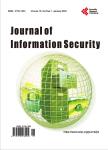Systematic Literature Review on Cloud Computing Security: Threats and Mitigation Strategies
Systematic Literature Review on Cloud Computing Security: Threats and Mitigation Strategies作者机构:National Coalition of Independent Scholars Seattle United States
出 版 物:《Journal of Information Security》 (信息安全(英文))
年 卷 期:2024年第15卷第2期
页 面:148-167页
学科分类:08[工学] 0812[工学-计算机科学与技术(可授工学、理学学位)]
主 题:Cloud Security Threat Analysis Mitigation Strategies Emerging Trends Ethi-cal Considerations Data Analysis
摘 要:Cloud computing plays a significant role in modern information technology, providing organizations with numerous benefits, including flexibility, scalability, and cost-efficiency. However, it has become essential for organizations to ensure the security of their applications, data, and cloud-based networks to use cloud services effectively. This systematic literature review aims to determine the latest information regarding cloud computing security, with a specific emphasis on threats and mitigation strategies. Additionally, it highlights some common threats related to cloud computing security, such as distributed denial-of-service (DDoS) attacks, account hijacking, malware attacks, and data breaches. This research also explores some mitigation strategies, including security awareness training, vulnerability management, security information and event management (SIEM), identity and access management (IAM), and encryption techniques. It discusses emerging trends in cloud security, such as integrating artificial intelligence (AI) and machine learning (ML), serverless computing, and containerization, as well as the effectiveness of the shared responsibility model and its related challenges. The importance of user awareness and the impact of emerging technologies on cloud security have also been discussed in detail to mitigate security risks. A literature review of previous research and scholarly articles has also been conducted to provide insights regarding cloud computing security. It shows the need for continuous research and innovation to address emerging threats and maintain a security-conscious culture in the company.



